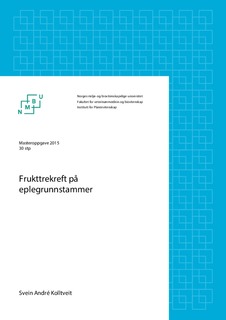| dc.description.abstract | The apple canker disease (aka European canker), which is caused by the fungus Neonectria
distissima, infects apple trees and can cause severe damage on both the fruit and the tree itself.
For some time it has been assumed that apple trees may be infected as early as the planting stage.
There is, however, no previous documentation on rootstock infection. If rootstocks can get
infected, how does this happens and what is the entry point for the infection? This project has
investigated the issue by means of testing different kinds of rootstocks and different methods of
inoculation.
The different methods used were inoculation by pricking the rootstock with needles containing
inoculum, spraying the rootstocks with a spore suspension and dripping spore suspension in the
wound made after cutting off the top shoot of the rootstock. Inoculation occurred at different
dates, and the rootstocks received different treatments of pinching and topping.
The experiments showed that all rootstocks may become infected by apple canker, although there
was a difference in how effective the different methods of inoculation were. The rootstocks
which were inoculated by needles containing inoculum had a high probability of developing
infections and showed symptoms of infection after four weeks. Needles with inoculum inserted
into the shoots provoked earlier symptoms than those inserted into the stem. Inoculation by
spraying the rootstocks with a spore suspension developed very little infection, and did not show
symptoms until eleven weeks after inoculation. Results also showed that, the rootstocks were
most prone to develop infections if they were pinched the same day as they were sprayed with
spore suspension. Rootstocks pinched one or three days before being sprayed with spore
suspension developed fewer infections.
All rootstocks tested, M9, B9, M26 and MM106, developed infections of apple canker, and there
was no difference in susceptibility. When wounds were made in the rootstock, either by pricking
with a needle or by cutting the top off, the infection levels after inoculation were high. If the
wounds were made by pinching off the shoots, however, the probability of infection was low.
Wounds in younger tissue were more susceptible for infection than wounds in older tissue.
The results show that to reduce the risk of infection of apple canker, it is important to be
considerate while handling rootstocks to avoid damages. When pinching, topping and grafting
one should take precautions to avoid apple canker and be aware of potential sources of inoculum
in the near vicinity. | nb_NO |

